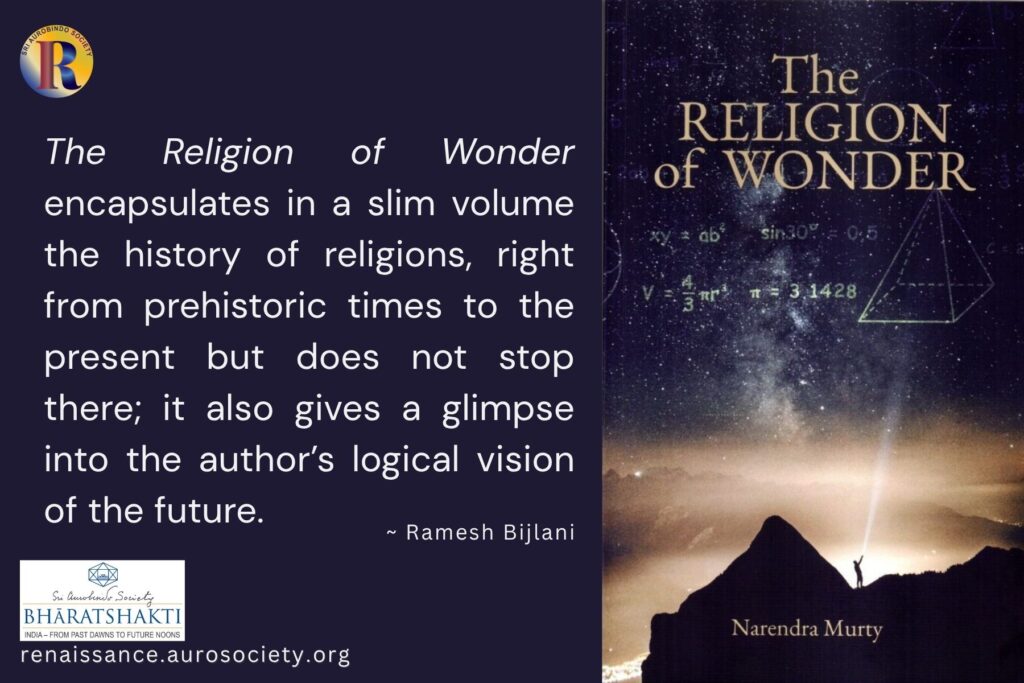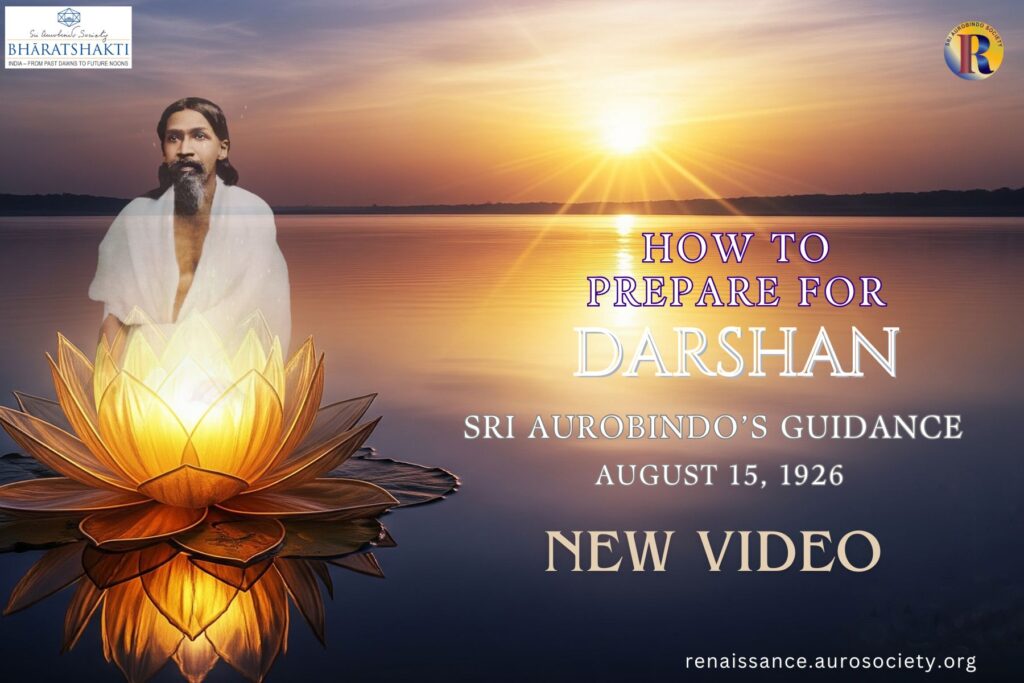Volume II, Issue 7
Author: Ananda Reddy
Continued from Part 1
At the beginning of the third paragraph, we come across Sri Aurobindo’s oft-quoted sentence:
“For all problems of existence are essentially problems of harmony.”
(CWSA, Vol. 21, p. 4)
The word ‘harmony’ connotes multiplicity; we cannot speak of harmony within the non-dual One. So, wherever there is multiplicity, there is bound to be divergence, division and disharmony. This division is maintained by the ego, the individualizing factor, and therefore, the dividing factor in us. The ego does not allow any movement towards harmony, for harmony, in the deeper sense of the word, implies sacrifice of one’s ego.
The average individuals, who think that their very existence and individuality depend solely upon their ego, are afraid to give up their ego. Therefore, he or she tries to avoid or run away from the problems of life for fear of losing this false ‘self’. The practical person tries to make the best of the situation by making a “rough, utilitarian and unillumined compromise” (p. 4).
In reality, this is no true solution, because no deeper harmony has been realised in this manner. Any unity achieved is at best a form of uniformity, or a semblance of temporary peace.
It is only the awakened man or the true yogi who, by the sacrifice of his ego, brings down a higher consciousness which can alone bring true peace and a deep-seated permanent harmony. Such a process is seen not only on the human level, but is the basic and fundamental method of Nature in her universal striving.
Disharmony Spurs the Human Aspiration
In the middle of the third paragraph, Sri Aurobindo writes:
The greater the apparent disorder of the materials offered or the apparent disparateness, even to irreconcilable opposition, of the elements that have to be utilized, the stronger is the spur. . .
(CWSA, Vol. 21, pp. 4-5)
We have seen in our lives that when we are passing through difficulties, we are at the most receptive level of our consciousness if we take them in the proper spirit of sadhana.
They almost seem to come to spur the human aspiration and endeavor towards progress and perfection. Otherwise, if we experienced no contradictions or disharmony, we might slump into lethargy and make no progress at all.
Now, what are the apparently irreconcilable oppositions that Sri Aurobindo is speaking of? Are they what we humans experience normally — night and day or life and death? No! He puts forward these two deeper oppositions that Nature is trying to resolve:
- Inanimate Matter versus an Active Life
- Conscious Mind versus Unconscious Matter and Half-conscious Life
Inanimate Matter versus an Active Life
Sri Aurobindo points out that Nature was faced with deep oppositions which she had to reconcile in order to carry out evolution. First, she had to bring the Life principle into the inanimate Matter full of inertia and unconsciousness.
One can easily see the opposition between Life and Matter—one is vibrant and active, the other dull and inert. Nature has taken millions of years to overcome this evolutionary hurdle and bring forth the apparent miracle of Life from seemingly lifeless and inanimate Matter.
At present, we possess all the qualities of Life, that is to say, we are alive, active and process a self-consciousness. But the tamas, the inertia of Matter, pulls us downwards. We are unable to soar into the higher levels of consciousness in life. We are constantly dragged down by the lower tendencies of jealousy, anger, desire, etc. At all times there is a pervasive tamas and ignorance that surrounds us.
Because of this inertia and resistance from Matter to change, the Life principle has brought in a transitory solution—that of death. But this is only a temporary compromise.
What then is the ultimate solution? Are we to live always under the shadow of death? It need not be so!
Sri Aurobindo says that the solution would be to achieve “the material immortality of a fully organised mind-supporting animal body.’’ (CWSA, Vol. 21, p. 5) Until and unless we achieve such an immortality of the body, there will be no solution to this inertia-ridden life.
Conscious Mind versus Unconscious Matter and Half-conscious Life
Regarding half-conscious life and unconscious matter versus conscious mind and conscious will, Sri Aurobindo writes that the solution to this opposition is to evolve a perfect instrument that possesses knowledge directly. He calls this instrument the supramental consciousness, or the Supermind.
Mind is only a seeker of knowledge, not a possessor of a perfected knowledge. Mind possess knowledge only indirectly. It acquires a second-hand knowledge either through the imperfect senses or through mental images. Supermind, on the other hand, is a perfect instrument of direct knowledge, because objects are known by identity.
For example, here is an incense holder carved out of the sacred ‘Service tree’ near the Samadhi of Sri Aurobindo and the Mother. I can feel it, value it, adore it, still on the other hand, it is an object outside of me. Supermind can have a direct identification with this incense holder and know it by identity. It would know exactly the spirit, the love, the spiritual aura that is there in this little portion of the Service tree. From this example, we may venture a guess as to the main thesis of The Life Divine.
It is the solution to these contradictions at the heart of our existence that Sri Aurobindo is presenting within the fifty-six chapters of the book. Ultimately, he deals with the question of how we can achieve the immortality of the body itself through the possession of the Supermind.
A Permanent and Integral Solution
Sri Aurobindo has not merely given us just one more philosophy or one more revelation or one more spiritual experience. In fact, what he has given us is a permanent and integral solution to the millennial struggle of universal Nature which is endeavouring to bring forth ultimate solutions to these contradictions.
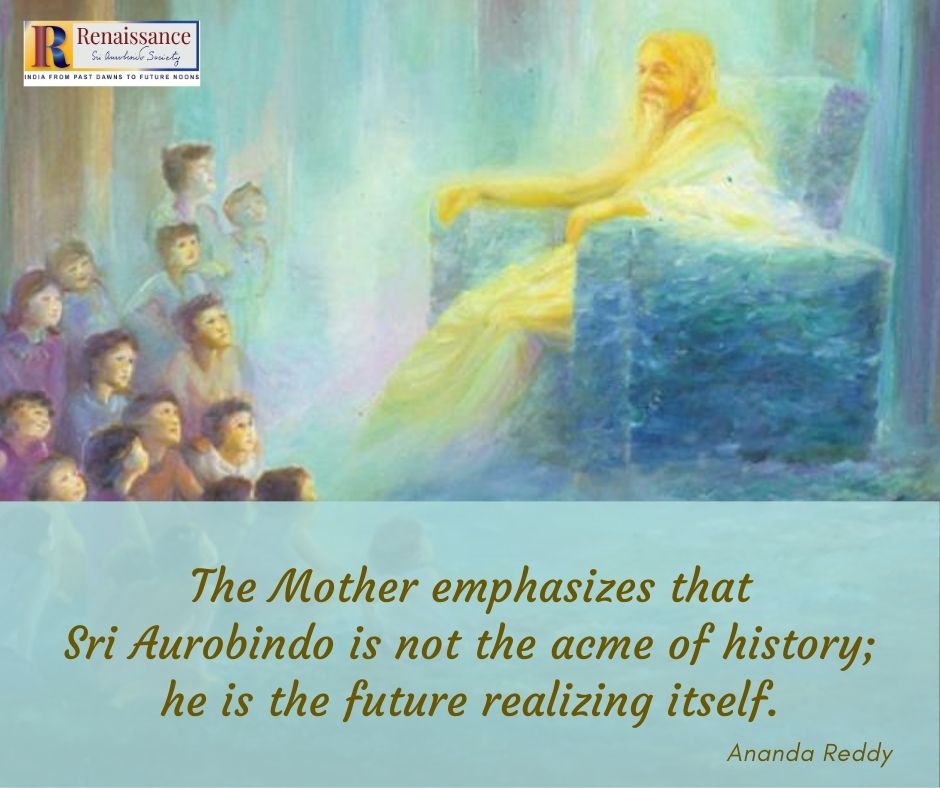
We may understand this better if we refer to Sri Aurobindo’s book on yoga, The Synthessis of Yoga. There he writes that all life is Nature’s own yoga and through yoga she evolves Life from Matter and Mind from Life. Within Matter is the hidden principle of life, which has always been there for nothing can come out of nothing.
The process of evolution can be exemplified by the analogy of an antenna within which are telescoped other antennas. From the basic antenna called Matter, Nature has pulled forth the antenna called Life, and inside Life there is the principle of Mind which was also pulled forth in the course of evolution. As Sri Aurobindo puts it:
“Matter is a form of veiled Life, Life a form of veiled consciousness.”
(CWSA, Vol. 21, p. 5)
Now the antenna of Supermind, which is hidden in Nature, is also being pulled forth by Nature.
Sri Aurobindo writes:
The animal is a living laboratory in which Nature has, it is said, worked out man. Man himself may well be a thinking and living laboratory in whom and with whose conscious co-operation she wills to work out the superman, the god. Or shall we not say, rather, to manifest God?
(CWSA, Vol. 21, p. 6)
So, we can easily conclude that Matter is bringing out from its womb the various layers of the hidden consciousness. Thus far, it has brought forth fully the levels of consciousness up to the level of Mind. But now, a new horizon in mankind’s evolutionary march is being revealed by Sri Aurobindo.
The Supramental Future
The Mother emphasizes that Sri Aurobindo is not the acme of history; he is the future realizing itself. For example, Leonardo da Vinci marks a high point in history, one in whom we get not just a unique artist but also a glimpse of the peak of human consciousness in those times.
But Sri Aurobindo is not simply another example of such a human excellence: he is the harbinger of the supramental future. He marks more than a culmination of the past. In addition, his life marks the beginning of a new adventure beyond the human consciousness towards the Supermind.
As each level of consciousness brings forth an instrumentation appropriate to its self-expression, so too the supramental consciousness will bring about the “necessary organs and faculties’’ (p. 6) that are suited to its own level of consciousness.
For example, the supramental body will be light, plastic and luminous. It will have spherical vision, i.e., it will be able to see all sides of any object simultaneously, as well as the inside an outside of it. It will have cosmic hearing, i.e., the supramental being will be able to hear the ‘music of the spheres’ as well. Sri Aurobindo describes these supramental faculties at length in the last chapters of his book The Synthesis of Yoga. . . .
This is the new logic of evolution that Sri Aurobindo presents in this chapter which is in fact convincing enough for one to accept the possibility or at least the probability of the ‘life divine’ manifesting upon earth.
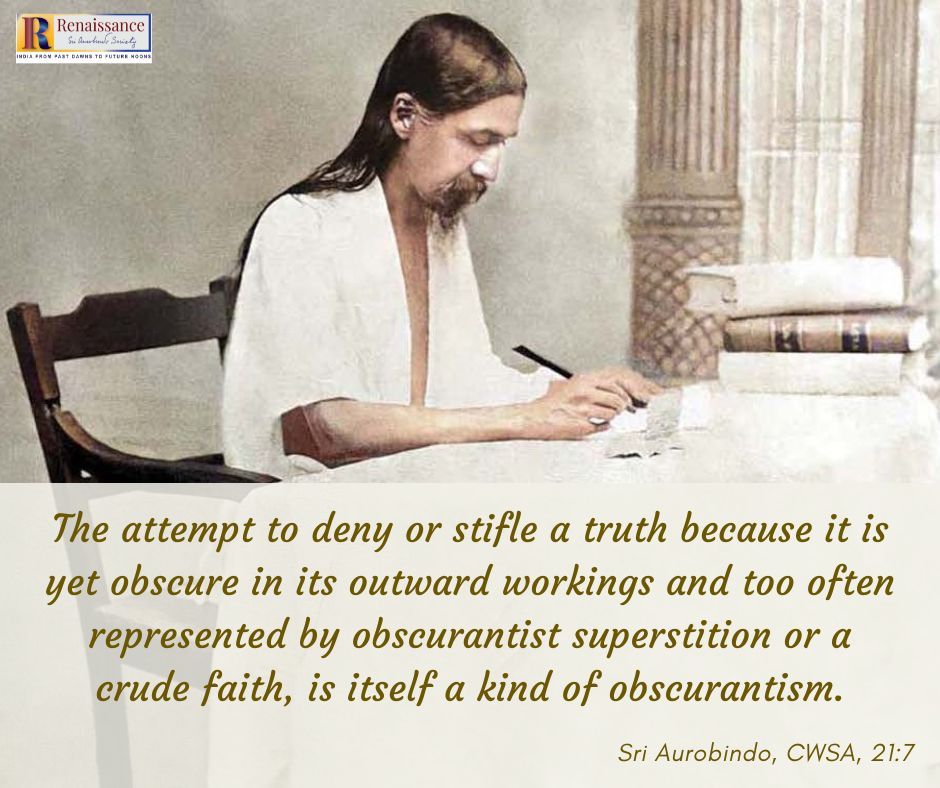
Immortal Aspiration of Man
Man may find it difficult to accept this eternal paradox of a divine life in an animal body and an ignorant mind, but the immortal aspiration of man has always returned to God, Light, Freedom and Immortality, and there can never be a permanent setback in this aspiration of man.
Man may deny the new possibilities of the divine life, because it seems too remote and impossible, but Sri Aurobindo says:
The attempt to deny or stifle a truth because it is yet obscure in its outward workings and too often represented by obscurantist superstition or a crude faith, is itself a kind of obscurantism.
(CWSA, Vol. 21, p. 7)
He continues:
The will to escape from a cosmic necessity because it is arduous, difficult to justify by immediate tangible results, slow in regulating its operations, must turn out eventually to have been no acceptance of the truth of Nature but a revolt against the secret, mightier will of the great Mother.
It is better and more rational to accept what she will not allow us as a race to reject and lift it from the sphere of blind instinct, obscure intuition and random aspiration into the light of reason and an instructed and consciously self-guiding will.
(CWSA, Vol. 21, p. 7)
This is typical of Sri Aurobindo! Not to deny or stifle a truth because its manifestation is yet too obscure.
Beware of Religionists and Rationalists
At one time, science proclaimed itself to be a very rational and logical system, and religion was considered to be obscurantist because it could not prove God’s existence. So, science rejected religion. Science has great openness of mind, but it has always rejected what it cannot see or what cannot be proven by the evidence of the senses.
This is the trap of an old argument against which Sri Aurobindo is cautioning us. Just because we do not have immediate and tangible results, let us not reject any particular possibility, whether we accept it or not.
We cannot,. . . bid her [Nature] pause at a given stage of her evolution, nor have we the right to condemn with the religionist as perverse and presumptuous or with the rationalist as a disease or hallucination any intention she may evince or effort she may make to go beyond.
(CWSA, Vol. 21, p. 6)
Sri Aurobindo tells the religionists not to be ‘presumptuous’ by opposing the truth of another religion. Religionists keep criticizing each other’s doctrines out of a perverse sense of judgment that rejects something simply because it does not belong to you.
Similarly, the rationalists reject views that are contrary to their own as “disease or hallucination.” Sri Aurobindo is advising us to beware of such traps and to keep away from both the religionists and the rationalists.
Truth of Tomorrow
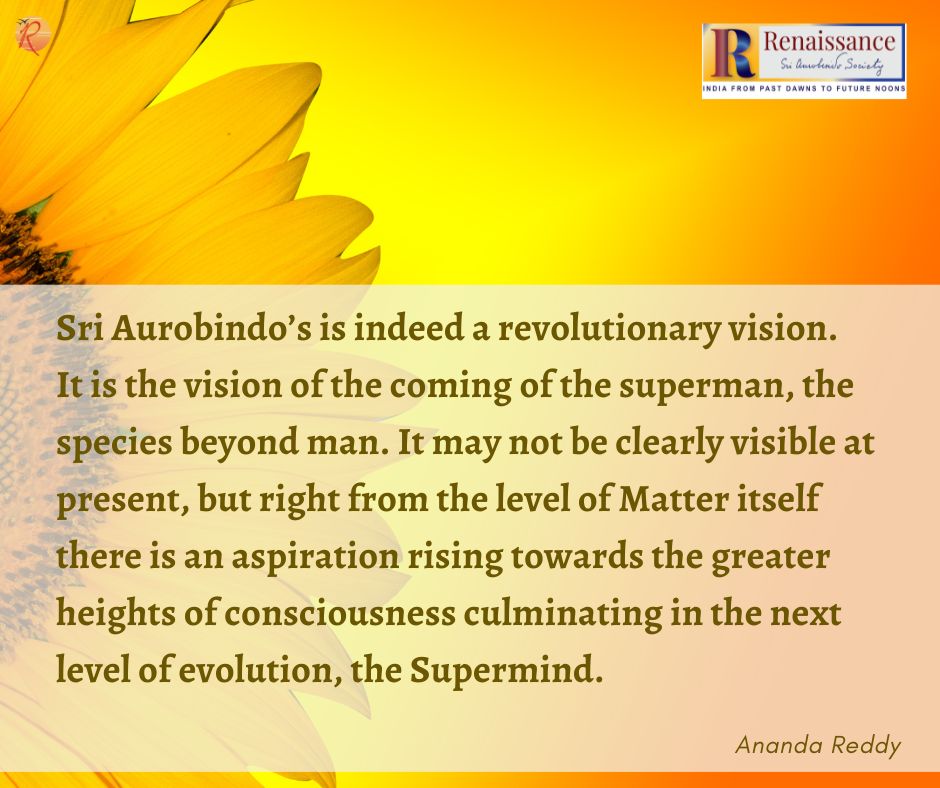
Sri Aurobindo’s is indeed a revolutionary vision. It is the vision of the coming of the superman, the species beyond man. It may not be clearly visible at present, but right from the level of Matter itself there is an aspiration rising towards the greater heights of consciousness culminating in the next level of evolution, the Supermind. This is the truth of tomorrow, and by being blind to this truth we may delay its full operation in human consciousness! So, Sri Aurobindo concludes:
For it is likely that such is the next higher state of consciousness of which Mind is only a form and veil, and through the splendours of that light may lie the path of our progressive self-enlargement into whatever highest state is humanity’s ultimate resting-place.
(CWSA, Vol. 21, p. 7)
Read Part 1

About the Author:
Dr. Ananda Reddy is Director, Sri Aurobindo Centre for Advanced Research (SACAR), Puducherry. He has travelled widely across India and the world giving deep discourses on various facets of Sri Aurobindo’s vision and works. An ex-student of Sri Aurobindo International Center of Education (SAICE) and a doctorate in Philosopshy, he has authored many books and articles on the philosophy and yoga of Sri Aurobindo including several volumes of Deliberations on The Life Divine.
The book featured here is published by SACAR, Puducherry (first edition 2007).
For more details on Deliberations on The Life Divine (all volumes) and other SACAR publications, click HERE.

~ Design: Beloo Mehra
Click HERE for more in our Book of the Month series.


